ISSN ONLINE(2278-8875) PRINT (2320-3765)
ISSN ONLINE(2278-8875) PRINT (2320-3765)
| P. Jagadeesh, G. Karthick Kumar Reddy, S. Venkatramana Reddy* Department of Physics, Sri Venkateswara University, Tirupati, Andhra Pradesh, India. |
| Corresponding Author: S. Venkatramana Reddy, Department of Physics, Sri Venkateswara University, Tirupati, Andhra Pradesh, India. |
| Related article at Pubmed, Scholar Google |
Visit for more related articles at International Journal of Advanced Research in Electrical, Electronics and Instrumentation Engineering
Neonatal Intensive Care Unit (NICU) is used for better temperature measurement, isolation from infection, specialized feeding to infants and to prevent hypothermia and hyperthermia. The NICU or incubator consists of a servo control system including temperature sensor to regulate incubator air temperature. Among the number of temperature sensors like thermocouples, thermistors, Mercury thermometers, digital temperature sensor (DTS), etc, DTS gives accurate results over analog temperature sensors. The objective of the work is to interface Programmable ADT7410 DTS to PIC18F8720 Microcontroller to monitor the infants body temperature. This sensor measures temperature with accuracy, high resolution and fast conversion. ADT7410 is a MEM based digital sensor, which is Programmable for High, Low and critical temperature limits. It also includes on-chip oscillator, Sigma-Delta modulator, temperature registers and interrupt pins. PIC microcontroller is used as core of servo control system to read and write temperature from sensor using I2C protocol, and to control peripherals like radiant warmer, buzzer, Relays and display the result on LCD monitor. The software program is written in C language and compiled to generate Hex file. The step by step process of the system is explained using flowchart
Keywords |
| Incubator, ADT7410 Digital temperature sensor and PIC18F8720 Microcontroller. |
INTRODUCTION |
| Premature babies are very sensitive and usually suffers with hypothermia and hyperthermia [1]. Cold stress or Hypothermia in the neonatal period can be defined as a body temperature less than 36.5°C (97.6°F). Vasomuscular responses of a neonatal are not adequate to create sufficient heat metabolically. In the case of newborn infants, especially preterm infants, immaturity of the thermo-regulatory system makes the infant more vulnerable to changes of environmental temperature. As the body temperature decreases, the baby becomes less active, lethargic, hypotonic and sucks poorly. As the condition progresses, it causes profound changes in body metabolism resulting in impaired cardiac function, hemorrhage, jaundice and death. In Hyperthermia, the temperature is greater than 37.2°C (98.9°F), which is not a fever but raise in body temperature of infants in response to infection with microorganisms. If the baby is in an incubator, the air temperature should be lowered [2]. |
| The neutral thermal environment is the temperature range where heat production is at the minimum needed to maintain normal body temperature of infants. It depends on Birth weight, post natal age, and whether the infant is clothed or naked [1]. The method used to keep the baby warm will depend on the above mentioned factors, which can be taken care by various devices such as Infant Incubators and Radiant Warmers [3]. An incubator is an apparatus used to maintain environmental conditions suitable for a neonate (newborn baby). It is used in preterm births or for some ill full-term babies [1].The radiant warmer is developed as an ‘open incubator’ that ensures ready access to the baby. It provides intense source of radiant heat energy to maintain infants body temperature and prevents cold stress [4]. To maintain the Axilla temperature of the baby in between 36.5°C to 37.2°C the infants are placed in incubator or radiant warmer [5]. The Axilla (position shown in fig.1) temperature is measured even it is lower than the central temperature of the baby. It is easy to probe, neither affected by environmental changes nor interferes with X-ray fields, and not heated by heating device directly [2]. |
 |
| In an incubator the temperature of an infant is probed by the sensor. Now a day’s many sensors such as thermocouples, thermistors, liquid thermometers and bimetallic strips are analog sensors available in market [6]. Fault tolerant control (FTC) has been increasing in the last few years because FTC system has the ability to increase complex systems reliability and performance requirement in the events of faults. Fault may lead to system degradation or any unacceptable performance of the system [7]. The new design and development of system is required to control the faults by self calibrated Digital Sensor with on-chip DAQ. MEMS based digital temperature sensors are more advantageous due to On-chip ADC, fast conversion and programmable. It reduces errors, cable losses and gives more accurate measurement. ADT7410 is MEMS based digital temperature sensor manufactured by Analog devices is chosen for this purpose and interfaced to PIC18F8720 microcontroller. Microcontroller acts as core of servo-control system, controls the peripherals like LCD, keypad, relays, buzzer, sensor and warmer in an incubator. Inter-Integrated Circuit (I2C) is a protocol developed by Phillips for synchronous serial communication for data transfer between a microcontroller and peripheral devices. The major advantage of this interface is that it uses only two communication lines, which are bidirectional [8, 9]. The data transfer between ADT7410 Temperature sensor and microcontroller Master Synchronous Serial Port (MSSP) module takes place through the I2C bus. |
HARDWARE DETAILS |
| Microchip introduced an 8-bit microcontroller, PIC18F8720, which is 80 pin TQFP package and the features are summarized in table I. |
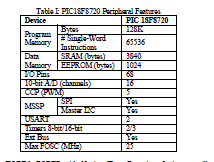 |
| PIC18F8720 has nine ports (PORTA- PORTJ) with 68 pins. These Port pins of microcontroller are multiplexed with other functions to reduce the pins to minimum number. Ports in the microcontroller are set as output port for binary data transfer and set as input port to receive the binary data from outside world. PORTC: Pin RC3/SCK/SCL, Pin RC4/SDI/SDA are used for I2C communication from peripheral to microcontroller and pin RC6/TX1/CK1, pin RC7/RX1/DT1 are used for RS232 Serial communication from Personal Computer to Microcontroller [10]. PORTB is used as data control port from microcontroller to LCD, Keypad, Relays, Buzzer and PORTD in PIC18F8720 as bidirectional port for data input from keypad and data output to LCD. |
| ADT7410 is a high accuracy digital temperature sensor with 13-bit/16-bit selectable temperature to digital on chip converter. The functional diagram of this sensor is shown in Figure 2 [11]. |
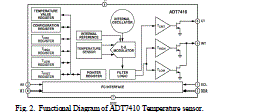 |
| ADT7410 sensor is I2C compatible interface, fast temperature converter, critical over temperature indicator, accuracy at ±0.5oC, programmable over/under temperature interrupt and internal oscillator for ADC. The sensor output is digitized by a sigma-delta modulator, consists of an input sampler, a summing network, an integrator, a comparator and a 1-bit DAC. In normal mode, the ADT7410 runs automatic conversion sequence which takes 240 ms to complete and the results are stored in respective registers. It has two address lines A0-A1 that enable the user to address four different ADT7410 sensor chips in the circuit [11]. 4x4 Matrix Keypad with Start, Stop, Minimum, Maximum, Reset, numeric from 0-9 optional buttons is interfaced to PIC18F8720 microcontroller, so that the system is controlled and maintained at specific temperature conditions. Keypad is interfaced to PORTD of PIC18F8720 through latch 74LS273 [12] for rows and through buffer 74HC244 [13] for columns. |
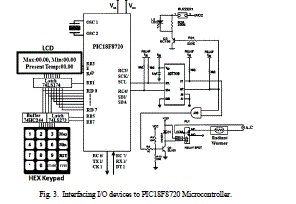 |
| The function keys are controlled through PORTB pins RB5 and RB7 by scan method. Microcontroller read data from keypad and sends ASCII character to display on 20x4 characters LCD. Data transfer to LCD is through PORTD and is enabled through PORTB pins RB1 and RB3. Relay is connected to ADT7410 INT & CNT pins through AND gate to control radiant warmer, and buzzer is connected to INT pin to indicate the over/under temperatures. All the detail interfacings are shown in figure 3. |
SOFTWARE DETAILS |
| MPLAB IDE is a software program that provides a single integrated development environment to generate Hex code and runs on Personal Computer to develop applications for PIC18F8720 microcontroller [7]. The MPLAB IDE provides the ability to create, edit source code using built-in editor, assemble, compile and link source code screen image of the software as shown in figure 4. The software program for the incubator temperature measurement and control system is written in C language and compiled to generate Hex file. Hex file is downloaded to PIC microcontroller via RS232 cable from PC through PIC ISP serial downloader software. After resetting the CPU of microcontroller the program starts execution. |
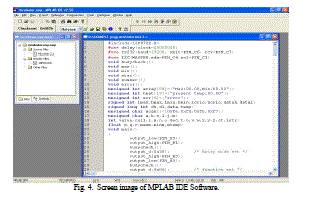 |
| ADT7410 digital temperature sensor is a programmable over/under and critical temperature interrupt and is activated by configuring the 8-bit data in the configuration register. High, Critical and Low temperatures are written to slave device via I2C protocol by Master controller when R/W bit is ‘0’. When temperature conversion completes in the ADT7410 sensor, the values are stored temporarily in Temperature register until the next conversion completes. When R/W bit is ‘1’, master reads present temperature data from Temperature register in slave sensor. Temperature data format for 13-bit resolution is given in table II. |
 |
| In the software programming, present temperature data in 13-bit is converted into ASCII code to display in the LCD. Additional program for controlling the radiant warmer is not required because CT & INT pins control the relay and radiant warmer with their logic. Registers with address & Power-on default values are given in table III. |
 |
| The control of the Digital temperature sensors and the operation of the Infants incubator warmer at the high and low temperature conditions were controlled with relays. The step by step process of the system is explained in the flow chart as given in figure 5. |
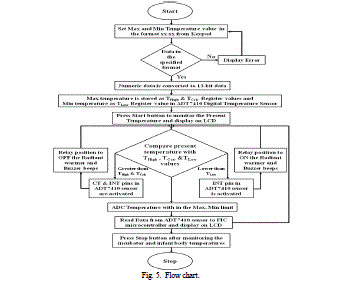 |
OPERATION |
| After downloading the program from PC to microcontroller, reset button is pressed to ON the process. PORT D is initialized as input port to scan the data from keypad and as output port to display data on LCD simultaneously. Initially Max button is pressed from keypad to enter maximum temperature value to be maintained for infants body temperature up to two digit decimal and two digit fractional value. This value is stored in THigh & TCric registers of ADT 7410 sensor to compare the high limit over/critical temperature from present conversion temperature value. Enter minimum temperature value by pressing min button and is stored in TLow register for under temperature and is compared with present conversion temperature value. The THigh and TLow are displayed on the LCD and the program temperature decimal values are converted into 13-bit digital code and transferred to ADT7410 Sensor via I2C bus. ADT7410 is configured to three modes, comparator mode, one shot conversion and 13-bit resolution by placing 0x3E code in the configuration register [11]. |
| Infants should be nursed in the neutral thermal environment and have a core body temperature between 36.5 – 37.2 degrees Celsius depending on weight of the baby. By measuring the weight of baby separately and then placed in incubator. Now start button is pressed on keypad to monitor the temperature of the incubator and infant body at various parts. Master controller PIC18F8720 transfer the High, Critical and Low temperature limits data to slave ADT7410 sensor through I2C bus. The logic levels to control the radiant warmer, CT & INT pins are given in the table IV. |
 |
SIMULATION & RESULTS |
| ADT7410 is configured with one shot mode temperature conversion, so it converts at 240 ms every sample. The sensor present conversion temperature values are compared with the High and Low temperature limits, if found greater than the THigh & TCric limit then INT, CT pins in ADT7410 goes to high state and relay position is switched to OFF the radiant warmer, and buzzer beeps indicate warning until it reach to low temperature limit. If the present temperature is lesser than the TLow limit then only INT pin go to high state and relay position is switched to ON the radiant warmer and buzzer beeps indicate warning until it reach to high temperature limit. Figure 6 shows the ON-OFF operation of radiant warmer with ADT7410 Sensor when the over/under temperature limits are reached. The process is continued to monitor the infants in good environment for health recovery. |
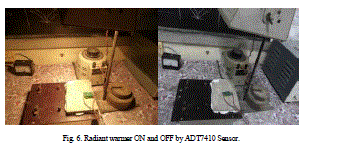 |
| The performance of the system with ADT7410 sensor is compared with another system with LM35 Analog temperature sensor. The distance of separation between warmer and sensors is kept 20cm as a fixed and temperatures are recorded for every one second. The air disturbance between warmer and sensors is causes with the 12 volts D.C fan so that the fluctuations in the air temperatures are measured by sensors. The performance of the sensors for one minute is plotted and shown in figure 7. |
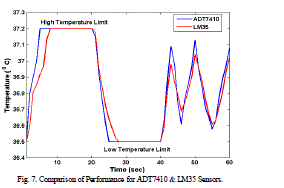 |
| Red color line is temperature profile of LM35 sensor and blue color line is ADT7410 sensor. From the graph it is clear that the response time by two sensors are good but ADT7410 is more reliable when compared with LM35. Only a few seconds variation exists between the sensors and response time is much better with ADT7410 digital sensor and its onchip data acquisition is faster to acquire data. The small fluctuations in temperature are easily measured by the on-chip ADT7410 sensor and also with high degree of resolution. The experimental result shows that the ADT7410 sensor is preferable to design the infant incubator to monitor the health of new born babies. The accuracy of the Sensor make pediatrician to take necessary medical action to protect infants from pollutants and infection. |
CONCLUSIONS |
| Digital Temperature sensor ADT 7410 is a fast on-chip digital temperature convertor, which converts at fast rate at 6 ms, 1 SPS (1 sample per second) at 60 ms and Normal conversion at 240 ms. Under observations and testing, we noticed that ADT 7410 has good response and faster than thermometers and thermistors and is an easy process to initialize the critical temperature limits. Using this sensor in real time applications, we can avoid PID controller in incubator. By interrupt generation in software programming using over/under temperature limits in ADT7410 digital temperature sensor, we controlled radiant warmer. The radiant warmer responds to INT and CT interrupts in ADT7410 sensor, which is important in controlling infants body temperature. This helps to maintain the incubator at supportive temperature for good health conditions for the infants. The Digital Temperature sensor with higher accuracy at ± 0.50C measurement is better than the thermistors or thermocouples. Cable losses are eliminated through this type of Digital measurements. |
AKNOWLEDGEMENT |
| The Authors are thankful to the Analog Devices Manufacturing Company, USA for providing free samples of ADT7410 Sensors. |
References |
|